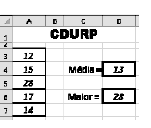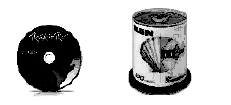Questões de Concurso
Comentadas para cdurp
Foram encontradas 14 questões
Resolva questões gratuitamente!
Junte-se a mais de 4 milhões de concurseiros!
Observe a planilha abaixo, criada no Excel 2010 BR.

Nela foram inseridas expressões:
• Em D4, para determinar a média aritmética entre os números 12 em A3 e 14 em A7.
• Em D6, para determinar o maior número entre todos no intervalo de A3 a A7.
As expressões inseridas em D4 e D6 foram, respectivamente:
 e
e  com o objetivo de, respectivamente, aplicar:
com o objetivo de, respectivamente, aplicar: Observe as figuras abaixo, relacionadas à mídia CD-R.

Uma característica de uma mídia CD-R é:

Essa conexão é conhecida por uma sigla e empregada por impressoras e pendrives. A sigla é:
• Todas as transações são executadas e alimentam o sistema no momento em que ocorrem. • O sistema funciona com suporte de um servidor de rede e acesso à internet. • É requisito básico do sistema o atendimento às solicitações no menor tempo de resposta possível.
Pelas características listadas, o sistema opera na seguinte modalidade de processamento:
Read the following text and answer question based on the text
A Potential Solution: Farm Vertically
Read the following text and answer question based on the text
A Potential Solution: Farm Vertically
Read the following text and answer question based on the text
A Potential Solution: Farm Vertically
Read the following text and answer question based on the text
A Potential Solution: Farm Vertically
Read the following text and answer question based on the text
A Potential Solution: Farm Vertically
Texto: Sobre o óbvio
A nossa classe dominante conseguiu duas coisas básicas: se assegurou a propriedade monopolística da terra para suas empresas agrárias, e assegurou que a população trabalharia docilmente para ela, porque só podia sair de uma fazenda para cair em outra fazenda igual, uma vez que em lugar nenhum conseguiria terras para ocupar e fazer suas pelo trabalho.
O alto estilo da classe dominante brasileira só se revela, porém, em toda a sua astúcia na questão da escravidão. A Revolução Industrial que vinha desabrochando trazia como novidade maior tornar inútil, obsoleto, o trabalho muscular como fonte energética. A civilização já não precisava mais se basear no músculo de asnos e de homens. Agora tinha o carvão, que podia queimar para dar energia, depois viriam a eletricidade e, mais tarde, o petróleo. Isso é o que a Revolução Industrial deu ao mundo. Mas os senhores brasileiros, sabiamente, ponderaram: - Não! Não é possível, com tanto negro à toa aqui e na África, podendo trabalhar para nós, e assim ser catequizado e salvo, seria uma maldade trocá-los por carvão e petróleo. Dito e feito, o Brasil conseguiu estender tanto o regime escravocrata, que foi o último país do mundo a abolir a escravidão.
O mais assinalável, porém, como demonstração de agudeza senhorial, é que ao extingui-la, o fizemos mais sabiamente que qualquer outro país. Primeiro, libertamos os donos da onerosa obrigação de alimentar os filhos dos escravos que seriam livres. Hoje festejamos este feito com a Lei do Ventre Livre. Depois, libertamos os mesmos donos do encargo inútil de sustentar os negros velhos que sobreviveram ao desgaste no trabalho, comemorando também este feito como uma conquista libertária. Como se vê, estamos diante de uma classe dirigente armada de uma sabedoria atroz.
Com a própria industrialização, no passado e no presente, conseguimos fazer treta. Nisto parecemos deuses gregos. A treta, no caso, consistiu em subverter sua propensão natural, para não desnaturar a sociedade que a acolhia. A industrialização, que é sabidamente um processo de transformação da sociedade de caráter libertário, entre nós se converteu num mecanismo de recolonização. Primeiro, com as empresas inglesas, depois com as ianques e, finalmente, com as ditas multinacionais. O certo é que o processo de industrialização à brasileira consistiu em transformar a classe dominante nacional de uma representação colonial aqui sediada, numa classe dominante gerencial, cuja função agora é recolonizar o país, através das multinacionais. Isto é também uma façanha formidável, que se está levando a cabo com enorme elegância e extraordinária eficácia.
RIBEIRO, Darcy. “Sobre o óbvio”. In: Ensaios insólitos.
Rio de Janeiro: Ludens, 2011. 2 ed. Páginas 19 e 20.
[Fragmento adaptado]